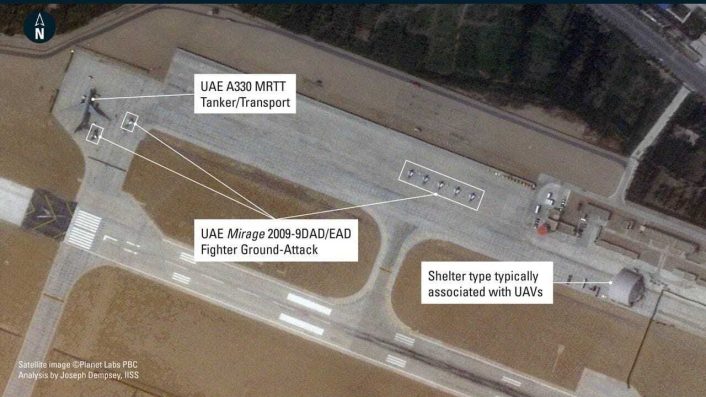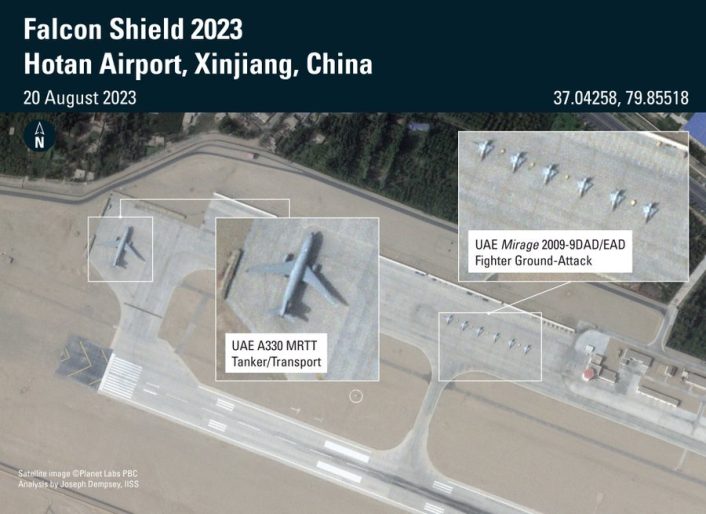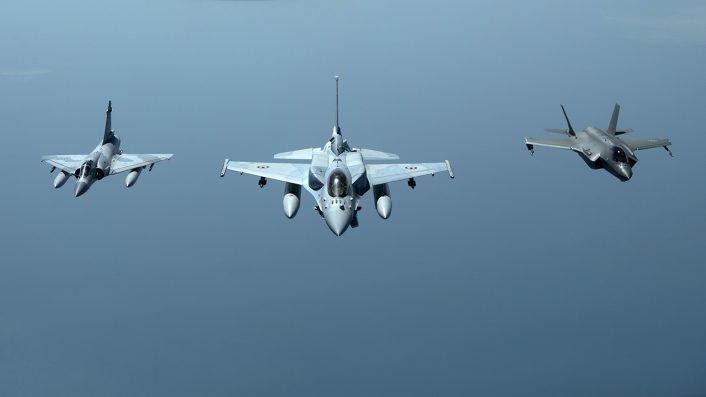China could benefit from familiarizing itself with the Mirage 2000’s performance and capabilities, as well as from the possibility of engaging in dissimilar air-combat training. This preparation could be advantageous in the event of a conflict with Taiwan.
The Falcon Shield 2024 aerial exercise between the UAE and China’s PLAAF (PLA Air Force) will allow Beijing greater access to Western and European military aircraft technology. The drills, which began on Jul. 10, 2024, and will continue until the end of this month, see the UAE Air Force deploying its French-made Mirage 2000 jets to a Chinese airbase.
According to a report by the IISS (International Institute of Strategic Studies), this is a concern since the aircraft type is used by both the Taiwanese and the Indian Air Forces, two of China’s regional adversaries. The think tank analyzed satellite images of the air base at Hotan, in Xinjiang province, which shows at least seven Dassault Mirage 2000-9DAD/EAD jets.

This variant of the Mirage is specialized in ground-attack and deep penetration strikes, although it still retains a robust air-to-air capability. Taiwan is currently reported to have 54 Mirage 2000 in service, out of the initial order of 60 aircraft in the 1990s, which included 48 single-seater Mirage 2000-5EI and 12 twin-seater Mirage 2000-5DI.
انطلاق التمرين العسكري المشترك “درع الصقر 2024” مع الصين
في إطار التعاون المشترك بين دولة الامارات العربية المتحدة وجمهورية الصين الشعبية، أعلنت وزارة الدفاع عن انطلاق التمرين العسكري المشترك “درع الصقر 2024” بين القوات الجوية للبلدين.
يأتي هذا التمرين بهدف تبادل الخبرات ورفع… pic.twitter.com/dlahafSQVK
— وزارة الدفاع |MOD UAE (@modgovae) July 16, 2024
Interestingly, reports said 30 of the UAE’s Mirage 2009-D jets are slated to be transferred to Morocco to address its security concerns with Algeria, after receiving the green light from Paris. The UAE are also in the process of replacing the Mirages with new Dassault Rafale F4s.
The drills
Other UAE aircraft involved in the exercise included an Airbus A330 MRTT aircraft. The 2023 installment of the exercise also saw the participation of Mirage jets, together with two Boeing C-17A Globemaster cargo planes. The 2024 version also includes the addition of a temporary shelter often associated with Unmanned Aerial Vehicle (UAV) operations.
The UAEAF also flies the US-made Lockheed Martin F-16E/F Block 60, which however was not part of the Falcon Shield exercise. While China could use some first hand experience with the F-16, since Taiwan also has 142 in inventory and has ordered a further 66 aircraft, the UAE could have faced serious consequences if the type was deployed to China.
The UAE MoD said on X: “This exercise aims to exchange experiences, raise the operational efficiency of both sides, and focus on implementing joint operations to raise the readiness of the participating forces and optimally employ various capabilities to confront air threats.” The accompanying photo showed UAEAF and PLAAF service members posing ahead of a Mirage 2000, a J-16 and a J-10.

Benefits for China
Nevertheless, this exercise “raises questions about the potential for information gathering on Western aircraft by Beijing,” mentioned the IISS. The think tank adds that “familiarization with the Mirage 2000 and its performance and capabilities, as well as the possibility of dissimilar air-combat training, would be of value to the PLAAF.” Dissimilar combat training against foreign aircraft lends a critical insight into tactics and technology, both of which mutually influence each other.
In particular, pilots can look for the other aircraft’s technical characteristics like radar, communications frequencies, engine, kinematic performance and features like missile and radar locks. These are discussed thoroughly during debriefs where air forces analyze direct or indirect evidence of potential weakness and develop countermeasures and tactics.
Conversely, China can improve its own defense aerospace technology by putting it through such drills. In China’s case specifically, this will have a direct defense industrial measure since most of its frontline fighters like the J-10 series, Su-30MKK, J-11, J-16 and the J-20, are manufactured within the country, with all supply chains originating domestically. This makes technical, engineering and software tweaks on its radars, missiles or seekers easier and faster.

Being the host nation allows China to possibly use, “overtly or covertly,” assets like AEW (Airborne Early Warning) “to monitor the exercise, potentially providing further insights into the ability of Chinese AEW radar to detect the Mirage 2000,” adds the IISS. “Depending on the nature of the joint exercise, the performance of Chinese fighter radar and electro-optical and radio-frequency missile seekers could also be examined.”
For instance, PLAAF can examine the seeker performance and detection range of the PL-10 short-range AAM (Air-to-Air Missile), that uses an IIR (Imaging Infrared) seeker, “during any dissimilar air-to-air combat exercises” against the Mirages. “The PLAAF likely has used its air activity in and around Taiwan’s Air Defence Identification Zone and any Taiwanese air force response to examine radar and seeker performance. An air exercise, however, offers a more manageable environment where simulated engagements could be repeated multiple times.”
Triple challenge to the U.S.
This exercise also comes amid a burgeoning defense aerospace heft to Chinese and UAE relations. Abu Dhabi in early 2022 ordered a dozen Hongdu L-15A jets to replace the Aermacchi MB-339, part of its Al Fursan aerobatic display team. China began delivering the aircraft in the fourth quarter of 2023. Discussions are underway for another 36 aircraft, possibly for the advanced jet trainer or light attack roles.
UAE also operates Chinese-made MALE (Medium-Altitude Long Endurance) drones like the Wing Loong II, assigned to Qusawirah air base. In this backdrop, UAE and Chinese aerial exercises pose a three-pronged strategic, diplomatic and defense technological challenge to Washington.

